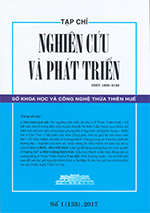Nghiên cứu lịch sử, chức năng ấn Sắc mệnh chi bảo (từ độ tụ của sử liệu)/The study of history, function of the seal Sắc mệnh chi bảo (from the convergence of historical documents).
Tóm tắt
Hiện vật bằng gỗ mang dòng chữ “Sắc mệnh chi bảo” khai quật được ở Hoàng thành Thăng Long năm 2013 là một hiện vật khảo cổ được giới khoa học và xã hội quan tâm trong khoảng thời gian gần đây. Đã có nhiều ý kiến khác nhau trong việc nghiên cứu và giám định cổ vật này, trong đó có ý kiến cho rằng đây là chiếc ấn thời Trần. Bài viết này đề xuất khái niệm “độ tụ của sử liệu” để nhận định về niên đại văn hóa của hiện vật đang xét, tức là nghiên cứu hiện vật này từ nhiều nguồn sử liệu khác nhau (bao gồm hiện vật khảo cổ và tư liệu chữ viết) ở góc độ liên ngành. Về mặt lý thuyết, khi “độ tụ của sử liệu” càng cao thì giả thuyết càng thuyết phục. Kết quả khảo cứu của bài viết cho thấy độ tụ của các sử liệu đều tập trung cho giả thuyết: loại ấn triện SMCB và chế độ “Sắc mệnh” là một sản phẩm văn hóa vùng, là sản phẩm của chế độ chính trị ở khu vực Đông Á. Chế độ này nhằm thể hiện quyền lực của bậc đế vương qua hình thức thăng thưởng cho quan lại và thăng trật cho hệ thống bách thần (đặc biệt ở Việt Nam). Nó khởi đầu từ năm 1368 ở Trung Quốc, sau đó ảnh hưởng đến Đại Việt năm 1435 và đến Triều Tiên năm 1479. Do vậy mà ít có khả năng, hiện vật Sắc mệnh chi bảo phát hiện tại Hoàng thành Thăng Long là chiếc ấn thời Trần.ABSTRACT
THE STUDY OF HISTORY, FUNCTION OF THE SEAL “SẮC MỆNH CHI BẢO”(from the convergence of historical documents)
Recently, researchers have taken interest in the wooden seal “Sắc mệnh chi bảo” unearthed in Thăng Long Imperial Citadel in 2013. There are various opinions during the study and survey of that artifact, including the one confirmed that it was the seal of the Trần Dynasty. This article proposes the concept of “convergence of historical documents” to determine the cultural chronology of an examined object, id est to study the artifact from various sources (including archaeological artifacts and written documents) under disciplinary angles. Theoretically, the higher “convergence of historical documents” gets, the more convincing the theory is.The research results of the article show that the convergence of historical documents centers on the hypothesis that the type of “Sắc mệnh chi bảo” seal and the “royal decree” form were products of the political regimes in East Asia to manifest the power of emperors through the conferment of higher ranks of mandarins as well as gods (especially in Vietnam). It began in 1368 in China, then spread to Đại Việt in 1435 and arrived in Korea in 1479. Therefore, it is unlikely that the object discovered in Thăng Long Imperial Citadel was a seal under the Trần Dynasty.

